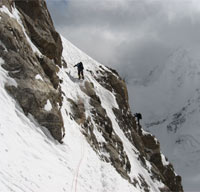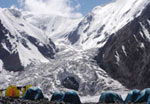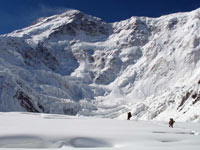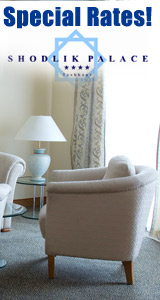Uzbekistan Uzbekistan Central Asia , which used to be part of the Soviet Union. It is bordered on the west and north by Kazakhstan, on the east by Kyrgyzstan, on the southeast by Tajikistan, and on the south by Afghanistan and Turkmenistan. Uzbekistan includes the Karakalpak Autonomous Republic, which occupies about 37 percent of Uzbekistan's territory. Uzbekistan's land area totals about 447,400 sq km (about 172,750 sq mi). Tashkent is the capital and chief industrial and cultural center. Slightly more than 36 percent of the total population live in urban areas.Tashkent , the capital of Uzbekistan, is the largest city in Central Asia and the fourth largest in the former USSR (after Moscow, Saint Petersburg, and Kyiv). Other major cities include Samarkand , Namangan, Andijon, and Bukhara .Climate and the nature conditions of Uzbekistan climate and the nature conditions of Uzbekistan are among the most favorable in Central Asia. For example, in the former capital of Kazakhstan, Almaty, which is 502 mi northeast of Tashkent, the average annual temperature is 5-8 degrees lower. At the same time, 804 mi southwest of Tashkent in Ashgabat, the average annual temperature is 8-10 degrees higher. melons , grapes , apples , quinces , and pears of Uzbekistan have an incredibly delicious taste. More than 60 species of orchards grow in Uzbekistan many of which started traveling around the world from their geographical centre of origin.Zaamin mountain archa state reserve area of more than 26 thousand hectares is situated in heights from 1760 up to 3500 meters above sea level. Juniper forests make up a special value and beauty of the reserve. The local type of this surprising and having become rare plant is accepted to be called archa in Central Asia. It is relative to the well known cypress. Yet not so long ago the main tree of mountain forests of Uzbekistan was called a plant of not our epoch. Archa was related to extinct breed unmanageable for artificial reproduction. As scientists found out it were not so easy to reproduce it in natural way, besides, it grows very slowly. Only 700-800 aged trees reach 8-10 meters height. Trees which age exceeds a thousand and even three thousands years are met in secluded mountain regions which are difficult of access.Chatkal state biospheric reserve in the west Tyan-Shan spurs locating on the heights from 1 100 up to 4 000 meters above the sea level and taking a square of more than 35 thousand hectares is inimitable and diverse. Mountain landscapes are distinguished here by their variety, wildness and beauty. The climate advantages of Uzbekistan attract mountain-skiers to the Chimgan-Beldersay area near Tashkent, which belongs to Chatkal state biospheric reserve. The combination of snow and mostly warm, sunny weather makes the Chimgan and Beldersay ski slopes extremely popular. More than 27 thousand biological types are counted in ecosystems of Uzbekistan. The fauna is represented by 424 species of birds, 97 species of mammals, 58 species of reptiles and 83 species of fish. Plants, mushrooms and algae are represented by 11 thousand of species. Many animals and plants are endemic and are not met anywhere in the globe.PageTour - Uzbekistan tourist attractions So, what attracts tourist in Uzbekistan after all . According to the Statistical Internet Survey, carried out in May 7-August 27, 2008 by Pagetour jointly with Walter Kafer Fremdenverkehrdienstleistungen, the majority of those surveyed - 39%, visit the country because of their interest to architectural and historical sights of Uzbekistan . Another largest group - 24% visit Uzbekistan for the sake of acquaintance with culture, way of life and local customs . Thereby most of the tourists (63%) visiting Uzbekistan, consider as an attractions the following: historical places, monuments, museums and art galleries, ancient buildings and structures (e.g., ancient fortresses, mosques, madrasahs, libraries, former prisons, wells), national parks, national festivals and other cultural events.204 sights and attractions (not counting the hotels) on 5 maps with descriptions available and with 448 photos including: Tashkent - 83 photos ; Samarkand - 141 photos ; Bukhara - 198 photos ; Khiva - 26 photoss . Tashkent - 27 hotels ; Samarkand - 14 hotels ; Bukhara - 28 hotels ; Khiva - 5 hotels ); with 542 photos .120 photos of Mountaineering in Uzbekistan. In all: 1103 photos . Plus Photo Clipart 1000% of Uzbekistan with about 1000 high-resolution photos available. Altogether: 2103 photos are available with this site!
Tashkent
Tashkent
Most travel involves entering and leaving Uzbekistan through Tashkent, the
capital city of Uzbekistan. Tashkent was the fourth largest city in the Soviet
Union but you wouldn't know it with the sheep that wander the streets under the
watchful eye of their turbaned shepherds. But as Tico after Tico races by,
followed by hundreds of Daewoo Nexias, and the metro rumbles underneath, you
begin to understand the complexity that is Tashkent. Though Tashkent is often
overlooked in the search for the Silk Road oasis towns of Samarkand, Bukhara and
Khiva, Today one can visit such striking sights as Mausoleum of Sheikh Zaynudin
Bobo, Sheihantaur or Mausoleum of Zangiata. It is only Tashkent that melds
Sufism, Marxism and Capitalism, the East, West and Russia, as well as tradition
and modernism. Other Central Asian capitals lack the complexity and overall
cultural mix of Tashkent.
Samarkand
The site of Samarkand was settled about 2000 BC. In times of old the city
was also known as Afrosiab, and also Maracanda by the Greeks. The city was the
capital of Sogdiana, an ancient Persian province, and was conquered by Alexander
the Great in 329 BC. It subsequently grew as a trade center on the route between
China and the Mediterranean region. In the early 8th century AD, it was
conquered by the Arabs and soon became an important center of Muslim culture. In
1220 Samarkand was almost completely destroyed by the Mongol ruler Genghis Khan.
Bukhara
Bukhara
Nevertheless, most of intact historic buildings in this city belong to
period of the late Middle Ages. Only numerous archaeological excavations in the
20-th century revealed thick cultural layers with traces of ancient settlements
in location of the present-day Bukhara.
Hotels in Bukhara
Khiva
Hotel Islambek
Malika-Heivak Hotel (former Lola) is very good located - in the center
of Inner City - Ichan-Kala - among remarkable sights of ancient Khiva - Islam
Khodja ensemble, Pakhlavan Mahmud Mausoleum and Dzhuma Mosque. The hotel has
simply furnished rooms with bathrooms and AC. It also operates as B&B. if you
want to have other meals you should order in the morning.
Arkanchi hotel
Hotel Sobir Arkonchi is situated in the historical Inner City of Khiva -
Ichan-Kala. Most of the hotel rooms afford a fine view to the walls of
Ichan-Kala and other remarkable sights. There are a big garden with fruit trees
and flowers and a summer swimming pool on the hotel site.
The Malika hotel is part of a small chain of hotels. Rooms have AC,
private facilities, hairdryer etc. There is also a restaurant where breakfast is
served, and a gift shop. The best thing about this hotel is its location, right
opposite the west gate of the old city. If you are awake at the right time, you
can watch the sunrise over the city walls.
23 Essential facts about Tourism in Uzbekistan
Tourism in Uzbekistan Uzbekistan tourism is regulated by
laws and development programs. The appropriate normative-legal base which
impacts the status of tourism was being formulated during almost 20 years in
Uzbekistan.The existing legislation includes a following list of most important
documents .
The Law "On tourism" was approved, by Oliy Majlis on 20 August 1999. It
regulates state policy in the sphere of tourism, defines legislative norms for
this sector of economy, including norms of relations between subjects and
objects of tourism.The Regulations "On the order of departure and entrance of tourists to the
Republic of Uzbekistan" . The appropriate provision has been approved in
order to regulate the entrance of foreign tourists into the Republic of
Uzbekistan and departure of citizens of the Republic of Uzbekistan abroad as
tourists, and to secure their safety. It was issued according to the Law of
Republic Uzbekistan "On tourism", Resolution of the Cabinet of Ministers of the
Republic of Uzbekistan dated 28 July 2004 No.360 "On further improvement of
Uzbektourism national company activities".Regulations "On licensing of tourist activity" . The Resolution of the
Cabinet of Ministers dated 11 November 2003 No.497 stipulates the procedure and
rules for receiving the license for tourist activities various subjects of
managing. The Order of certification of tourist services. It was registered
within the Ministry of Justice on 18 March 2000 No.911. It contains general
provisions, rules and procedures of carrying out obligatory certification of
tourist services rendered by subjects of tourist activities and can be also used
in carrying out voluntary certification.The Resolution "On simplification of visa procedures for Italian citizens"
of the Cabinet Of Ministers dated 19 February 2003 No.85. The Ministry for
Foreign Affairs of Uzbekistan was entrusted to issue multi-entry visas for one
month to citizens of Italian Republic visiting Uzbekistan as tourists within two
working days with a waver of presenting tourist vouchers of Uzbektourism or
other tourist organizations. Note: the same procedure covers citizens of France.
Latvia, Great Britain, Spain, Austria, Switzerland, Japan, Germany and Belgium."On granting exemption from customs duties to some tourist organizations" .
The Ministry of Finance (No.04-02-04/11) and the State Tax Committee (No.09-386
dated 12 January 1996) in order to implement the Decree of the President of the
Republic of Uzbekistan dated 2 July 1995 "On measures to facilitate
participation of the Republic of Uzbekistan in the revival of the Great Silk
Road and to develop international tourism in the republic" consider it possible
to support the proposal of Uzbektourism regarding exemption of tourist agencies
in Samarkand, Bukhara, Khiva and Tashkent cities from paying customs duties for
importing vehicles for their own use.The Decree "On measures to facilitate participation of the Republic of
Uzbekistan in the revival of the Great Silk Road and to develop international
tourism in the republic" . The decree of the President of Republic Uzbekistan
dated 2 June 1995. The document stipulates the following:"The Order on entrance to and departure from the Republic of Uzbekistan of
foreign citizens and persons without citizenship" . The Resolution of the
Cabinet of Ministers dated 21 November 1996, No.408. Foreign citizens, including
citizens from CIS countries and without citizenship can enter Uzbekistan and
leave on the reasons of private and business affairs, as tourists, for rest,
study, work, treatment and on a permanent residence. Entry, entry-exit and
transit visas are issued by the consular officers. Multi-entry visas for the
period of one year are issued by the Ministry of Foreign Affairs.
Sources: -
https://parus87.com/Read_More.htm National
normative-legal documents of Uzbekistan on tourism development by BVV Business
Report Newspaper
https://en.wikipedia.org/wiki/Tourist_attraction


























